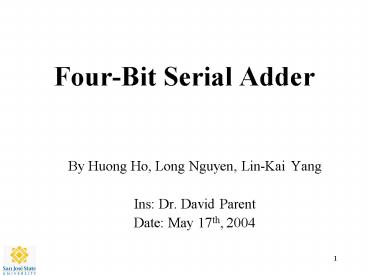FourBit Serial Adder - PowerPoint PPT Presentation
1 / 20
Title:
FourBit Serial Adder
Description:
We designed an 4-bit serial adder that operated at 200 MHz and used of ... ?pav. Gates. Logic. Level. Note: All widths are in microns and capacitances in fF. 8 ... – PowerPoint PPT presentation
Number of Views:349
Avg rating:3.0/5.0
Title: FourBit Serial Adder
1
Four-Bit Serial Adder
- By Huong Ho, Long Nguyen, Lin-Kai Yang
- Ins Dr. David Parent
- Date May 17th, 2004
2
Agenda
- Abstract
- Introduction
- Project Details
- Summary of Results
- Conclusions
3
Abstract
- We designed an 4-bit serial adder that operated
at 200 MHz and used of power 10.75mW and occupied
an area of 192x60 um².
4
Introduction
- Bit-serial structure is designed to process the
input one bit at a time, generally using the
results of the operations on the first bit to
influence the processing of subsequent bits. - Because it passes all the bits through the same
logic, bit-serial reduces a significant amount of
required hardware. Typically, the bit-serial
approach requires 1/nth of the hardware required
for the equivalent n-bit parallel design. - Bit-serial structure reduces signal routing
(1-bit signals instead of n-bit signals) and
higher-speed operation (one adder and a register
rather than an n-bit adder).
5
Introduction (cont.)
- The price of this logic reduction is that the
serial hardware takes n clock cycles to execute,
while the equivalent parallel structure executes
in one clock cycle. - Bit-serial architectures have been used
successfully in many applications that are
dealing with a bit stream such as signal
processing, audio, video etc. It was extremely
popular in the 2-5u technology range.
6
4-bit Serial Adder Schematic
7
Longest Path Calculations
Note All widths are in microns and capacitances
in fF
8
D-Flip Flop Calculations
9
D-Flip Flop Schematic
10
D-Flip Flop Waveform
11
Full Adder Schematic
12
Full Adder Waveform
13
4-bit Serial Adder Schematic
14
4-bit Serial Adder Waveform
15
4-bit Serial Adder Layout
Area 192 x 60 um²
16
Power Consumption
P 10.75 mW
17
DRC Extraction
18
4-Bit Serial Adder LVS
19
Summary of Results
20
Acknowledgements
- Thank you Dr. Parent for being so patient!!!
- Thanks to Cadence Design Systems for the VLSI
lab. - Thanks to our classmates who helped us in the
lab.































